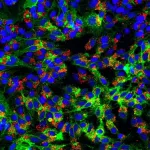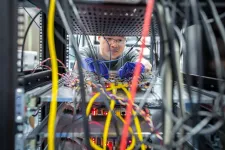This spectacular discovery is the result of the work of scientists from the international High-Altitude Water Cherenkov (HAWC) gamma-ray observatory. Located on the slopes of the Mexican Sierra Negra volcano, the observatory records high-energy particles and photons flowing from the abyss of space. In the sky of the Northern Hemisphere, their brightest source is the region known as the Cygnus Cocoon. At the HAWC, it was established that photons with energies even several dozen times greater than those recorded earlier by the Fermi-LAT and ARGO detectors arrive from the Cocoon. This fact suggests that the Cygnus Cocoon is the most powerful of the hitherto known particle accelerators in the Milky Way. The results of the research, in which scientists from the Institute of Nuclear Physics of the Polish Academy of Sciences (IFJ PAN) in Cracow played an important role, are presented in the prestigious journal Nature Astronomy.
"The discovery made thanks to the HAWC observatory is an important element of a scientific puzzle that has been going on for over a hundred years, the aim of which is to decipher the nature of cosmic rays, especially when speaking of particles with the highest energies occurring in our galaxy," says Dr. Sabrina Casanova (IFJ PAN), initiator of the latest data analysis from the Cygnus Cocoon region and its significant co-author.
The Cygnus Cocoon, a vast astronomical structure about 180 light years across, lies 4.6 thousand light years from the Sun. In our sky, we can find it almost exactly in the centre of the Cygnus constellation where it occupies an area of angular width similar to the four discs of the Moon. It is a region of intense formation of massive (and consequently short-lived) stars, with two young star clusters Cygnus OB2 and NGC 6910.
"The HAWC detector has greater sensitivity and angular resolution than previous devices of this type. With its use, during 1,343 days of observation we recorded photons of gamma rays with energies up to one hundred teraelectronvolts, coming from the direction of the Cygnus OB2 cluster. What could have been the source of such high-energy radiation?" wonders Dr. Casanova.
What emerges from the latest analysis of gamma radiation reaching the Earth from the Cygnus Cocoon is an interesting picture of phenomena of complex, multi-stage nature. High-energy cosmic rays are usually expected to come from supernova remnants, including pulsars. However, in supernova remnants protons or electrons do not have enough time to accelerate to a kinetic energy reaching several hundred teraelectronvolts. But then, inside a young cluster of massive stars, the turbulences of powerful stellar winds interacting with each other help to confine the particles for millions of years. Some of these particles have the chance to gain energies reaching petaelectronvolts.
"The situation is very complicated," notes Dr. Casanova, and clarifies: "Some particles are expected to gain really enormous energies inside these associations of massive stars thanks to the long confinement time, comparable to the million-year lifetime of the associations themselves. But the higher the energy of the particles, the shorter the confinement time. We expect that the highest energy particles escape the cluster before they emit the gamma photons we can observe. The question is: where is the maximum acceleration energy?"
The key question is the nature of the particles responsible for the emission of the high-energy photons that were recorded at the HAWC observatory. If the source of the photons were electrons, their energies would have to be several times greater than the energy of photons. However, if the source were protons, their energies would have to be as high as a petaelectronvolt. This value is one hundred times greater than the energy of proton collisions inside the LHC accelerator.
"Our analysis does not provide a clear conclusion regarding the origin of photons with energies reaching 100 TeV. It does, however, point to a clear favourite - protons with extreme energies, accelerated in collisions of stellar winds and then emitting gamma photons when colliding with interstellar material," says Dr Casanova.
If future observations confirm the present interpretation, the Cygnus OB2 star cluster in the interior of the Cygnus Cocoon would be the most powerful of all our galaxy's accelerators identified so far.
The Henryk Niewodniczanski Institute of Nuclear Physics (IFJ PAN) is currently one of the largest research institutes of the Polish Academy of Sciences. A wide range of research carried out at IFJ PAN covers basic and applied studies, from particle physics and astrophysics, through hadron physics, high-, medium-, and low-energy nuclear physics, condensed matter physics (including materials engineering), to various applications of nuclear physics in interdisciplinary research, covering medical physics, dosimetry, radiation and environmental biology, environmental protection, and other related disciplines. The average yearly publication output of IFJ PAN includes over 600 scientific papers in high-impact international journals. Each year the Institute hosts about 20 international and national scientific conferences. One of the most important facilities of the Institute is the Cyclotron Centre Bronowice (CCB), which is an infrastructure unique in Central Europe, serving as a clinical and research centre in the field of medical and nuclear physics. In addition, IFJ PAN runs four accredited research and measurement laboratories. IFJ PAN is a member of the Marian Smoluchowski Kraków Research Consortium: "Matter-Energy-Future", which in the years 2012-2017 enjoyed the status of the Leading National Research Centre (KNOW) in physics. In 2017, the European Commission granted the Institute the HR Excellence in Research award. The Institute holds A+ Category (the highest scientific category in Poland) in the field of sciences and engineering.
INFORMATION:
CONTACTS:
Dr. Sabrina Casanova
Institute of Nuclear Physics, Polish Academy of Sciences
tel: +48 12 6628274
email: sabrina.casanova@ifj.edu.pl
SCIENTIFIC PUBLICATIONS:
"HAWC observations of the acceleration of very-high energy cosmic rays in the Cygnus Cocoon"
The HAWC Collaboration
Nature Astronomy, 2021
DOI: https://doi.org/10.1038/s41550-021-01318-y
LINKS:
http://www.ifj.edu.pl/
The website of the Institute of Nuclear Physics, Polish Academy of Sciences.
http://press.ifj.edu.pl/
Press releases of the Institute of Nuclear Physics, Polish Academy of Sciences.
IMAGES:
IFJ210311b_fot01s.jpg
HR: http://press.ifj.edu.pl/news/2021/03/11/IFJ210311b_fot01.jpg
The Cygnus Cocoon region with the source of photons up to 100 TeV, coinciding with the young Cygnus OB2 cluster of massive stars. (Source: IFJ PAN / HAWC)
IFJ210311b_fot02s.jpg
HR: http://press.ifj.edu.pl/news/2021/03/11/IFJ210311b_fot02.jpg
Cygnus X, one of the brightest and closest star forming region in the Galaxy (marked in red), is at the centre of the Cygnus Cocoon, a vast astronomical structure that covers an area of Earth's sky an angular width of four lunar discs. (Source: IFJ PAN / Stellarium)
IFJ210311b_fot03s.jpg
HR: http://press.ifj.edu.pl/news/2021/03/11/IFJ210311b_fot03.jpg
The High-Altitude Water Cherenkov (HAWC) gamma-ray observatory, located on the slopes of the Mexican Sierra Negra volcano. (Source: HAWC Observatory)



